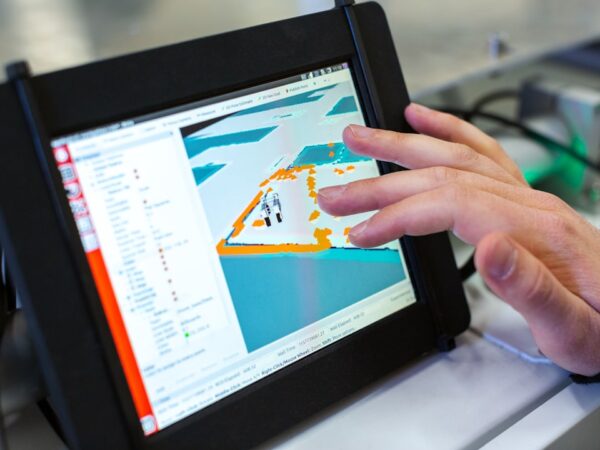
Streamlining User Management: The Top User Provisioning Software for Efficient Operations
User provisioning software is a tool that helps organizations manage user access to various systems and applications. It automates the process of creating, modifying, and deleting user accounts, as well as assigning and revoking user privileges. User provisioning software plays a crucial role in ensuring that the right people have the right access to the right resources at the right time.
Managing user access is a complex task for organizations, especially those with a large number of employees and multiple systems. Without proper user provisioning software, organizations may face security risks, inefficiencies, and compliance issues. User provisioning software provides a centralized platform for managing user access, streamlining the process, and ensuring that access rights are granted and revoked in a timely manner.
Key Takeaways
- User provisioning software streamlines user management and automates the process of granting and revoking access to resources.
- Benefits of using user provisioning software include increased security, improved compliance, and reduced administrative burden.
- Key features to look for in user provisioning software include role-based access control, automated workflows, and integration with other systems.
- Top user provisioning software in the market includes Okta, OneLogin, and Microsoft Azure Active Directory.
- User provisioning software works by automating the process of creating, modifying, and deleting user accounts and access rights.
Benefits of Streamlining User Management
Implementing user provisioning software offers several benefits to organizations:
Improved security: User provisioning software helps organizations enforce strong access controls and reduce the risk of unauthorized access. By automating the process of granting and revoking user privileges, organizations can ensure that only authorized individuals have access to sensitive information and systems.
Increased efficiency: Manual user management processes can be time-consuming and prone to errors. User provisioning software automates these processes, saving time and reducing the risk of human error. It also allows IT administrators to easily manage user accounts across multiple systems from a single interface.
Reduced costs: Automating user management processes can lead to cost savings for organizations. By eliminating manual tasks, organizations can reduce the time and resources required for user provisioning and deprovisioning. Additionally, user provisioning software can help organizations avoid costly security breaches by ensuring that access rights are properly managed.
Enhanced compliance: User provisioning software helps organizations meet regulatory requirements by providing an auditable trail of user access activities. It allows organizations to easily track and monitor user access, ensuring that access rights are aligned with business policies and regulations.
Features to Look for in User Provisioning Software
When selecting user provisioning software, there are several key features to consider:
Automated user onboarding and offboarding: User provisioning software should automate the process of creating user accounts and granting access rights when employees join the organization. Similarly, it should also automate the process of disabling or deleting user accounts when employees leave the organization.
Role-based access control: Role-based access control allows organizations to define roles and assign access rights based on job responsibilities. User provisioning software should support role-based access control, making it easier to manage user access and ensure that users have the appropriate level of access.
Self-service portal: A self-service portal allows users to request access to systems and applications, reducing the burden on IT administrators. User provisioning software should provide a self-service portal that allows users to request access, track the status of their requests, and reset their passwords.
Integration with other systems: User provisioning software should integrate with other systems, such as HR systems and identity management systems, to ensure that user information is synchronized across all systems. This integration helps streamline the user provisioning process and ensures that user access is properly managed.
Top User Provisioning Software in the Market
| Software Name | Vendor | Deployment | Features | Price |
|---|---|---|---|---|
| Okta | Okta Inc. | Cloud | Single Sign-On, Multi-Factor Authentication, Lifecycle Management, API Access Management | Starting at 2/user/month |
| OneLogin | OneLogin Inc. | Cloud | Single Sign-On, Multi-Factor Authentication, Lifecycle Management, API Access Management | Starting at 2/user/month |
| Azure Active Directory | Microsoft Corporation | Cloud | Single Sign-On, Multi-Factor Authentication, Lifecycle Management, API Access Management | Starting at 6/user/month |
| JumpCloud | JumpCloud Inc. | Cloud | Directory-as-a-Service, Single Sign-On, Multi-Factor Authentication, Lifecycle Management, API Access Management | Starting at 2.50/user/month |
| ADManager Plus | ManageEngine | On-premises | Active Directory Management, User Provisioning, Group Policy Management, Password Management | Starting at 595/year |
There are several user provisioning software solutions available in the market. Some of the top user provisioning software solutions include:
1. Okta: Okta is a cloud-based identity management platform that provides user provisioning capabilities. It offers features such as automated user onboarding and offboarding, role-based access control, and integration with other systems. Okta also provides strong security features, including multi-factor authentication and single sign-on.
2. OneLogin: OneLogin is another cloud-based identity management platform that offers user provisioning capabilities. It provides features such as automated user onboarding and offboarding, role-based access control, and self-service password reset. OneLogin also offers integration with other systems, including HR systems and Active Directory.
3. SailPoint: SailPoint is an identity governance platform that includes user provisioning capabilities. It offers features such as automated user onboarding and offboarding, role-based access control, and self-service password reset. SailPoint also provides advanced analytics and reporting capabilities to help organizations monitor and manage user access.
When comparing user provisioning software solutions, it is important to consider factors such as the specific needs of your organization, the scalability of the solution, and the level of support provided by the vendor. Pricing is also an important consideration, as user provisioning software solutions can vary widely in cost.
How User Provisioning Software Works
User provisioning software automates the process of creating, modifying, and deleting user accounts, as well as assigning and revoking user privileges. The user provisioning process typically involves several steps:
1. User request: The process begins when a user requests access to a system or application. This request can be made through a self-service portal or by contacting the IT department.
2. Approval workflow: Once a user request is received, it goes through an approval workflow. This workflow involves verifying the user’s identity and determining whether the requested access is appropriate based on the user’s role and responsibilities.
3. Account creation: If the user request is approved, the user provisioning software creates a user account in the target system or application. This includes creating a username and password for the user.
4. Access assignment: After the account is created, the user provisioning software assigns the appropriate access rights to the user based on their role and responsibilities. This may involve granting access to specific applications or systems, as well as defining the level of access (e.g., read-only or read-write).
5. Access revocation: When a user no longer requires access to a system or application, the user provisioning software revokes their access rights. This ensures that users only have access to resources that are necessary for their job responsibilities.
User provisioning software plays a crucial role in this process by automating these steps and ensuring that access rights are granted and revoked in a timely manner. It also provides a centralized platform for managing user access, making it easier for IT administrators to track and monitor user access activities.
Steps to Implement User Provisioning Software

Implementing user provisioning software involves several steps:
1. Planning and preparation: Before implementing user provisioning software, organizations should assess their current user management processes and identify areas for improvement. They should also define their requirements and objectives for the software implementation.
2. Software selection: Once the requirements are defined, organizations can evaluate different user provisioning software solutions and select the one that best meets their needs. This may involve conducting demos, evaluating features and functionality, and considering factors such as scalability, integration capabilities, and vendor support.
3. Configuration and customization: After selecting the software, organizations need to configure and customize it to align with their specific requirements. This may involve defining roles and access rights, setting up approval workflows, and integrating the software with other systems.
4. Testing and deployment: Once the software is configured, organizations should conduct thorough testing to ensure that it is working as expected. This may involve testing different scenarios, such as user onboarding, offboarding, and access assignment. After testing is complete, the software can be deployed to production.
It is important to involve key stakeholders throughout the implementation process and provide training and support to users. This helps ensure a smooth transition to the new user provisioning software and maximizes its benefits.
Best Practices for User Provisioning Software
To maximize the benefits of user provisioning software, organizations should follow these best practices:
1. Establish clear policies and procedures: Organizations should establish clear policies and procedures for user provisioning, including guidelines for granting and revoking access rights. These policies should be communicated to all employees and regularly reviewed and updated as needed.
2. Regularly review and update access rights: Access rights should be regularly reviewed and updated to ensure that users have the appropriate level of access. This includes reviewing user roles and responsibilities, as well as conducting periodic access reviews to identify and remove any unnecessary access rights.
3. Provide training and support to users: Users should be provided with training and support on how to use the user provisioning software and understand their role in the user provisioning process. This helps ensure that users are aware of their responsibilities and can effectively request and manage their access rights.
Common Challenges of User Provisioning and How to Overcome Them
Implementing user provisioning software can come with its own set of challenges. Some common challenges include:
1. Lack of visibility and control: Without proper user provisioning software, organizations may lack visibility and control over user access. This can lead to security risks and compliance issues. To overcome this challenge, organizations should implement user provisioning software that provides a centralized platform for managing user access and offers robust reporting and auditing capabilities.
2. Inconsistent processes: In organizations with manual user management processes, there may be inconsistencies in how access rights are granted and revoked. This can lead to inefficiencies and errors. User provisioning software helps standardize the user provisioning process, ensuring that access rights are consistently managed across the organization.
3. Resistance to change: Implementing user provisioning software may face resistance from employees who are accustomed to manual processes or fear job loss. To overcome this challenge, organizations should communicate the benefits of the software implementation, provide training and support to users, and involve key stakeholders throughout the process.
Case Studies: Successful Implementation of User Provisioning Software
There are several examples of organizations that have successfully implemented user provisioning software:
1. Company A: Company A, a large financial institution, implemented user provisioning software to streamline its user management processes. The software allowed the organization to automate the process of creating and deleting user accounts, as well as assigning and revoking access rights. As a result, the organization was able to improve security, increase efficiency, and reduce costs.
2. Company B: Company B, a global technology company, implemented user provisioning software to enhance its compliance efforts. The software provided a centralized platform for managing user access and offered robust reporting and auditing capabilities. This helped the organization meet regulatory requirements and ensure that access rights were aligned with business policies.
3. Company C: Company C, a healthcare organization, implemented user provisioning software to improve its security posture. The software allowed the organization to enforce strong access controls and reduce the risk of unauthorized access. It also provided advanced analytics and reporting capabilities, helping the organization monitor and manage user access.
In all of these cases, the implementation of user provisioning software resulted in significant benefits for the organizations, including improved security, increased efficiency, reduced costs, and enhanced compliance.
Future of User Provisioning Software and Trends to Watch Out For
The future of user provisioning software is likely to be shaped by several trends:
1. Emerging technologies: Emerging technologies such as artificial intelligence and machine learning are likely to have an impact on user provisioning software. These technologies can help automate and streamline the user provisioning process even further, improving efficiency and accuracy.
2. Shift towards cloud-based solutions: There is a growing trend towards cloud-based solutions in the field of user provisioning software. Cloud-based solutions offer scalability, flexibility, and ease of deployment, making them an attractive option for organizations.
3. Importance of data privacy and security: With increasing concerns about data privacy and security, organizations are likely to place a greater emphasis on securing user access. User provisioning software will need to continue evolving to address these concerns and provide robust security features.
In conclusion, user provisioning software plays a crucial role in managing user access in organizations. It offers several benefits, including improved security, increased efficiency, reduced costs, and enhanced compliance. When selecting user provisioning software, organizations should consider features such as automated user onboarding and offboarding, role-based access control, self-service portal, and integration with other systems. Implementing user provisioning software involves several steps, including planning and preparation, software selection, configuration and customization, and testing and deployment. To maximize the benefits of user provisioning software, organizations should establish clear policies and procedures, regularly review and update access rights, and provide training and support to users. Despite the challenges that may arise during implementation, successful case studies demonstrate the positive outcomes that can be achieved with user provisioning software. Looking ahead, emerging technologies, the shift towards cloud-based solutions, and the importance of data privacy and security are likely to shape the future of user provisioning software.
FAQs
What is user provisioning software?
User provisioning software is a tool that automates the process of creating, managing, and disabling user accounts and access to resources within an organization’s IT infrastructure.
What are the benefits of using user provisioning software?
User provisioning software helps organizations to streamline their user management processes, reduce the risk of security breaches, improve compliance, and increase operational efficiency.
What features should I look for in user provisioning software?
Some of the key features to look for in user provisioning software include automated user onboarding and offboarding, role-based access control, self-service user management, and integration with other IT systems.
What are some popular user provisioning software solutions?
Some popular user provisioning software solutions include Okta, OneLogin, Microsoft Azure Active Directory, SailPoint, and IBM Security Identity Manager.
How do I choose the best user provisioning software for my organization?
To choose the best user provisioning software for your organization, you should consider factors such as your organization’s size and complexity, your budget, the level of automation and customization you require, and the level of support and training provided by the vendor. It is also recommended to read reviews and compare features of different solutions before making a decision.


















